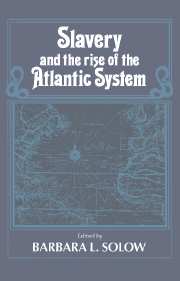Book contents
- Frontmatter
- Contents
- Preface
- List of contributors
- Introduction
- 1 Slavery and colonization
- 2 The Old World background of slavery in the Americas
- 3 Slavery and lagging capitalism in the Spanish and Portuguese American empires, 1492–1713
- 4 The Dutch and the making of the second Atlantic system
- 5 Precolonial western Africa and the Atlantic economy
- 6 A marginal institution on the margin of the Atlantic system: The Portuguese southern Atlantic slave trade in the eighteenth century
- 7 The apprenticeship of colonization
- 8 Exports and the growth of the British economy from the Glorious Revolution to the Peace of Amiens
- 9 The slave and colonial trade in France just before the Revolution
- 10 Slavery, trade, and economic growth in eighteenth-century New England
- 11 Economic aspects of the growth of slavery in the seventeenth-century Chesapeake
- 12 Credit in the slave trade and plantation economies
- Index
Introduction
Published online by Cambridge University Press: 20 October 2009
- Frontmatter
- Contents
- Preface
- List of contributors
- Introduction
- 1 Slavery and colonization
- 2 The Old World background of slavery in the Americas
- 3 Slavery and lagging capitalism in the Spanish and Portuguese American empires, 1492–1713
- 4 The Dutch and the making of the second Atlantic system
- 5 Precolonial western Africa and the Atlantic economy
- 6 A marginal institution on the margin of the Atlantic system: The Portuguese southern Atlantic slave trade in the eighteenth century
- 7 The apprenticeship of colonization
- 8 Exports and the growth of the British economy from the Glorious Revolution to the Peace of Amiens
- 9 The slave and colonial trade in France just before the Revolution
- 10 Slavery, trade, and economic growth in eighteenth-century New England
- 11 Economic aspects of the growth of slavery in the seventeenth-century Chesapeake
- 12 Credit in the slave trade and plantation economies
- Index
Summary
THE inclusion of the New World in the international economy ranks among the important events in modern history. Slavery was the foundation of that inclusion in its early chapters, and slavery accounts for the growth and importance of the transatlantic trade. The chapters in this volume thus place the study of slavery in the mainstream of international history.
Europeans brought 8 million black men and women out of Africa to the New World between the sixteenth and nineteenth centuries, and slavery transformed the Atlantic into a complex trading area uniting North and South America, Europe, and Africa through the movement of men and women, goods, and capital. It was slavery that made the empty lands of the western hemisphere valuable producers of commodities and valuable markets for Europe and North America: What moved in the Atlantic in these centuries was predominantly slaves, the output of slaves, the inputs to slave societies, and the goods and services purchased with the earnings on slave products. To give just one example, by the late seventeenth century, the New England merchant, the Madeiran vintner, the Barbadian planter, the English manufacturer, the English slave trader, and the African slave trader were joined in an intricate web of interdependent economic activity. Slavery thus affected not only the countries of the slaves' origins and destinations but, equally, those countries that invested in, supplied, or consumed the products of the slave economies.
- Type
- Chapter
- Information
- Slavery and the Rise of the Atlantic System , pp. 1 - 20Publisher: Cambridge University PressPrint publication year: 1991
- 12
- Cited by

